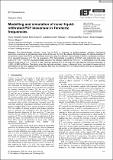| dc.contributor.author | Suhaimi, Nurul | |
| dc.contributor.author | Yakasai, Izaddeen | |
| dc.contributor.author | Abas, Emeroylariffion | |
| dc.contributor.author | Kaijage, Shubi | |
| dc.contributor.author | Begum, Feroza | |
| dc.date.accessioned | 2023-09-27T12:01:38Z | |
| dc.date.available | 2023-09-27T12:01:38Z | |
| dc.date.issued | 2020-07-23 | |
| dc.identifier.uri | https://doi.org/10.1049/iet-opt.2020.0069 | |
| dc.identifier.uri | https://dspace.nm-aist.ac.tz/handle/20.500.12479/2080 | |
| dc.description | This research Article was published by IET Optoelectron., 2020, Vol. 14 Iss. 6, pp. 411-416 | en_US |
| dc.description.abstract | The liquid-infiltrated photonic crystal fibre (LI-PCF) is proposed for guiding terahertz radiation. Geometricalasymmetry is achieved by introducing a large ellipse in the core. By filling the ellipse with liquid cocaine, the optical properties ofthe photonic crystal fibre (PCF) are theoretically examined using finite element method-based COMSOL multiphysics software.At an operating frequency of 1 THz, the proposed LI-PCF demonstrates a sensitivity of 87.02% and confinement loss in theorder of 10−4 cm−1. The PCF also demonstrates extremely low effective material loss <0.01 cm−1, a birefringence of 0.018, largeeffective mode area of 1.11 × 105 μm2, a high numerical aperture of 0.45 and near-zero ultra-flattened chromatic dispersion of1.4351 ± 0.5883 ps/THz/cm. The design simplicity and high sensitivity, strong confinement factor, low material losses and highbirefringence of the fibre suggest that the proposed fibre may be convenient for PCF-based cocaine sensing, for application inthe security and defence industries | en_US |
| dc.language.iso | en | en_US |
| dc.publisher | IET Optoelectronics | en_US |
| dc.subject | Research Subject Categories::TECHNOLOGY | en_US |
| dc.title | Modelling and simulation of novel liquid-infiltrated PCF biosensor in Terahertzfrequencies | en_US |
| dc.type | Article | en_US |

